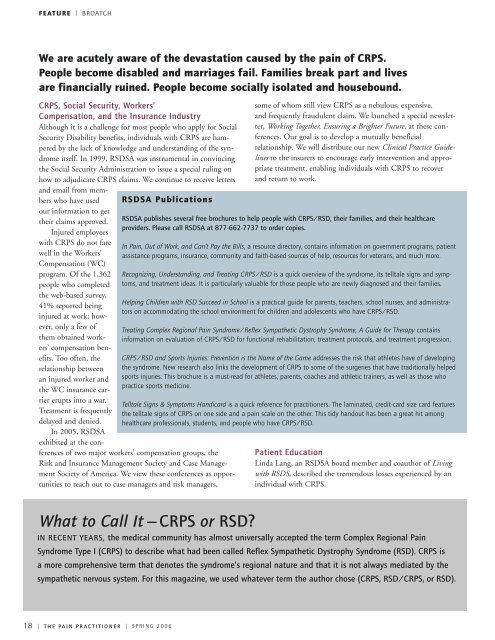printer-friendly version (PDF) - Reflex Sympathetic Dystrophy ...
printer-friendly version (PDF) - Reflex Sympathetic Dystrophy ...
printer-friendly version (PDF) - Reflex Sympathetic Dystrophy ...
Create successful ePaper yourself
Turn your PDF publications into a flip-book with our unique Google optimized e-Paper software.
FEATURE | BROATCH<br />
We are acutely aware of the devastation caused by the pain of CRPS.<br />
People become disabled and marriages fail. Families break part and lives<br />
are financially ruined. People become socially isolated and housebound.<br />
CRPS, Social Security, Workers’<br />
Compensation, and the Insurance Industry<br />
Although it is a challenge for most people who apply for Social<br />
Security Disability benefits, individuals with CRPS are hampered<br />
by the lack of knowledge and understanding of the syndrome<br />
itself. In 1999, RSDSA was instrumental in convincing<br />
the Social Security Administration to issue a special ruling on<br />
how to adjudicate CRPS claims. We continue to receive letters<br />
RSDSA Publications<br />
and email from members<br />
who have used<br />
our information to get<br />
their claims approved.<br />
Injured employees<br />
with CRPS do not fare<br />
well in the Workers’<br />
Compensation (WC)<br />
program. Of the 1,362<br />
people who completed<br />
the web-based survey,<br />
41% reported being<br />
injured at work; however,<br />
only a few of<br />
them obtained workers’<br />
compensation benefits.<br />
Too often, the<br />
relationship between<br />
an injured worker and<br />
the WC insurance carrier<br />
erupts into a war.<br />
Treatment is frequently<br />
delayed and denied.<br />
In 2005, RSDSA<br />
exhibited at the conferences<br />
of two major workers’ compensation groups, the<br />
Risk and Insurance Management Society and Case Management<br />
Society of America. We view these conferences as opportunities<br />
to reach out to case managers and risk managers,<br />
some of whom still view CRPS as a nebulous, expensive,<br />
and frequently fraudulent claim. We launched a special newsletter,<br />
Working Together, Ensuring a Brighter Future, at these conferences.<br />
Our goal is to develop a mutually beneficial<br />
relationship. We will distribute our new Clinical Practice Guidelines<br />
to the insurers to encourage early intervention and appropriate<br />
treatment, enabling individuals with CRPS to recover<br />
and return to work.<br />
RSDSA publishes several free brochures to help people with CRPS/RSD, their families, and their healthcare<br />
providers. Please call RSDSA at 877-662-7737 to order copies.<br />
In Pain, Out of Work, and Can’t Pay the Bills, a resource directory, contains information on government programs, patient<br />
assistance programs, insurance, community and faith-based sources of help, resources for veterans, and much more.<br />
Recognizing, Understanding, and Treating CRPS/RSD is a quick overview of the syndrome, its telltale signs and symptoms,<br />
and treatment ideas. It is particularly valuable for those people who are newly diagnosed and their families.<br />
Helping Children with RSD Succeed in School is a practical guide for parents, teachers, school nurses, and administrators<br />
on accommodating the school environment for children and adolescents who have CRPS/RSD.<br />
Treating Complex Regional Pain Syndrome/<strong>Reflex</strong> <strong>Sympathetic</strong> <strong>Dystrophy</strong> Syndrome, A Guide for Therapy contains<br />
information on evaluation of CRPS/RSD for functional rehabilitation, treatment protocols, and treatment progression.<br />
CRPS/RSD and Sports Injuries: Prevention is the Name of the Game addresses the risk that athletes have of developing<br />
the syndrome. New research also links the development of CRPS to some of the surgeries that have traditionally helped<br />
sports injuries. This brochure is a must-read for athletes, parents, coaches and athletic trainers, as well as those who<br />
practice sports medicine.<br />
Telltale Signs & Symptoms Handicard is a quick reference for practitioners. The laminated, credit-card size card features<br />
the telltale signs of CRPS on one side and a pain scale on the other. This tidy handout has been a great hit among<br />
healthcare professionals, students, and people who have CRPS/RSD.<br />
Patient Education<br />
Linda Lang, an RSDSA board member and coauthor of Living<br />
with RSDS, described the tremendous losses experienced by an<br />
individual with CRPS.<br />
What to Call It —CRPS or RSD?<br />
IN RECENT YEARS, the medical community has almost universally accepted the term Complex Regional Pain<br />
Syndrome Type I (CRPS) to describe what had been called <strong>Reflex</strong> <strong>Sympathetic</strong> <strong>Dystrophy</strong> Syndrome (RSD). CRPS is<br />
a more comprehensive term that denotes the syndrome’s regional nature and that it is not always mediated by the<br />
sympathetic nervous system. For this magazine, we used whatever term the author chose (CRPS, RSD/CRPS, or RSD).<br />
18 | T H E PA I N P R A C T I T I O N E R | S P R I N G 2 0 0 6
















